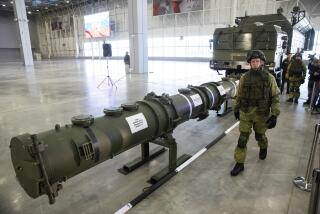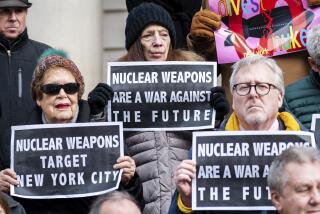U.S. to Strive for Strategic Missile Pact : Issue to Be Discussed at Shultz Meeting With Shevardnadze
- Share via
WASHINGTON — Even before the last words of a medium-range missile agreement are written, the Reagan Administration has decided to focus on a more ambitious and significant goal, reducing intercontinental offensive nuclear weapons, when Soviet Foreign Minister Eduard A. Shevardnadze arrives here for key meetings later this month, senior U.S. officials say.
Shevardnadze’s meetings with Secretary of State George P. Shultz on Sept. 15-17 will also deal in depth with the start of new talks to limit nuclear weapons testing, clear up remaining differences in the medium-range missile negotiations and address plans for a summit meeting in Washington later this year.
Late November or early December are the most likely times for that meeting, officials said this week, although they emphasized that no dates have been set.
Some officials believe that there is a real possibility that the Soviets are prepared to give up their demands to curb the Administration’s controversial Strategic Defense Initiative, or “Star Wars” program, which they have previously tied to a 50% cut in the offensive weapons of both sides.
These optimists cite the reduced attacks by Soviet propagandists and negotiators on SDI, as well as the general scaling down of Kremlin demands to restrict the kind of work conducted in the program. Moreover, they believe that the Soviets have taken heart in the growing hostility of the Democratic-controlled Congress toward the program and the consensus of weapons experts that a space-based missile shield will not become reality in this century.
Promise on ‘Star Wars’
They hope, one official said, that the Soviets will now settle for a U.S. promise not to deploy a space-based missile defense for at least 10 years. Soviet leader Mikhail S. Gorbachev rejected such a proposal at the Reykjavik, Iceland summit last year when Reagan offered the 10-year hiatus but insisted that the United States would be free to deploy SDI after that period.
The United States has not changed its position, a fact that makes most officials skeptical that the Soviets will now reverse themselves. But the skeptics believe that the “historic opportunity” that emerged from the Reykjavik meeting--when the two leaders agreed to seek a 50% cut in strategic missiles--should not be allowed to escape because of the anticipated new treaty to eliminate all medium-range nuclear missiles.
“At least one final try should be made to achieve a radical cut in strategic weapons during this Administration,” as one of them said this week. “We’re going to make it.”
Basis for SALT II
Until now, most officials and experts outside government had concluded that the Administration intended to settle for a medium-range missile agreement, with an outside possibility of converting the Reykjavik formula of 50% reductions into a more formal document similar to the Vladivostok accord of 1974. That accord became the basis for the SALT II agreement in 1979, which the U.S. Congress never ratified.
Some officials would settle for a Vladivostok-like accord, but others insist on a full-blown treaty, one ready by spring that could be signed at a follow-up summit in Moscow and ratified by Congress before the presidential campaign season begins next summer.
“Another ‘agreement in principle’ on arms control will only give the Democrats in Congress another excuse to cut the defense budget,” one senior aide complained.
The most likely tangible result of the Shultz-Shevardnadze meeting, officials said, was new nuclear testing talks. These were almost achieved at Reykjavik last October but failed, ostensibly over disagreement on a name for the negotiations, when the summit collapsed over the broader issue of SDI.
The basic difference is that the Soviets want talks aimed at ending all nuclear tests while the Administration insists that some tests--perhaps fewer and at a lower maximum yield--are needed to check the reliability of the weapons stockpile, develop warheads for new weapons being designed and improve safety features.
But the U.S. officials say the Soviets have moved closer to accepting the U.S. view that the new negotiations should proceed step by step through four stages: improving verification procedures to prevent cheating; ratifying two old agreements that limit underground tests of 150 kilotons (150,000 tons of TNT equivalent) in yield; reducing the limit on the size of tests and imposing a limit on the annual number to be conducted; and moving toward a total test ban in conjunction with reductions in offensive weapon arsenals.
A major step was taken last week when a Soviet defense official, Col. Nikolai Chervov, said in Washington that Moscow was willing to exchange scientists and techniques to monitor tests at each other’s test sites in an effort to improve verification procedures. Each country might even set off a nuclear test at the other’s test site and measure its power with its own instruments, he suggested.
New Nuclear Testing Talks
Both ideas were proposed by Reagan at Reykjavik and rejected by the Soviets. Chervov’s comments, effectively accepting the proposals, now suggest that an agenda for new nuclear testing talks may be set at the Shultz-Shevardnadze meeting, U.S. officials said. But they cautioned that the new talks may not be publicly announced until a summit is held.
Medium-range missile negotiations, meanwhile, appear to present no major difficulties at this point for the two ministers to resolve. New problems could crop up in coming weeks to block a summit meeting, however, as the two sides move into the final stage of talks on key verification measures.
After a series of recent compromises, the Soviet Union and the United States are now prepared to eliminate their medium-range missiles--those with a range of between 300 and 3,000 miles, also called intermediate-range nuclear forces, or INF.
Initially, the Soviets wanted to retain 100 warheads in this category but changed their minds over the summer. As a result, the United States lessened its demands for on-site verification measures. Most recently, the West German government announced that it would dismantle its 72 Pershing I-A missiles, which can reach a target at 460 miles, when the U.S. and Soviet missiles were eliminated.
Among the differences still existing is the Soviet insistence that the United States pledge within the new treaty to withdraw the warheads for the 72 West German Pershings. Washington refuses, on the grounds that the treaty deals only with missiles, not warheads, and that the United States will not deal with the Soviets on weapons held cooperatively with its allies.
Rate of Dismantlement
Other differences lie in the period during which the medium-range missile agreement would be implemented and the pace of dismantlement of the weapons.
The United States wants all the weapons eliminated within three years; the Soviets want the period to be five years. The United States wants the Soviets to reduce their 1,323 warheads on 441 SS-20 missiles to U.S. levels--248 warheads on 248 missiles--before America begins its own reductions; the Soviets want equal percentage reductions on both sides at the same rate.
Finally, the United States has reduced its verification demands to four kinds of on-site inspections:
-- To confirm the number of missiles and warheads each side possesses when the treaty comes into effect.
-- To confirm the destruction and dismantling of the weapons.
-- To confirm, during the reduction period, that production and other missile activities had stopped at facilities identified as associated with medium-range missiles.
-- To monitor suspected sites associated with ballistic missiles that can reach targets at more than 300 miles.
Because U.S. agencies were still working out details of these four demands last week for presentation to the Soviets at the arms negotiations in Geneva, it is not yet certain that verification difficulties of the past have been cleared up.
More to Read
Sign up for Essential California
The most important California stories and recommendations in your inbox every morning.
You may occasionally receive promotional content from the Los Angeles Times.










